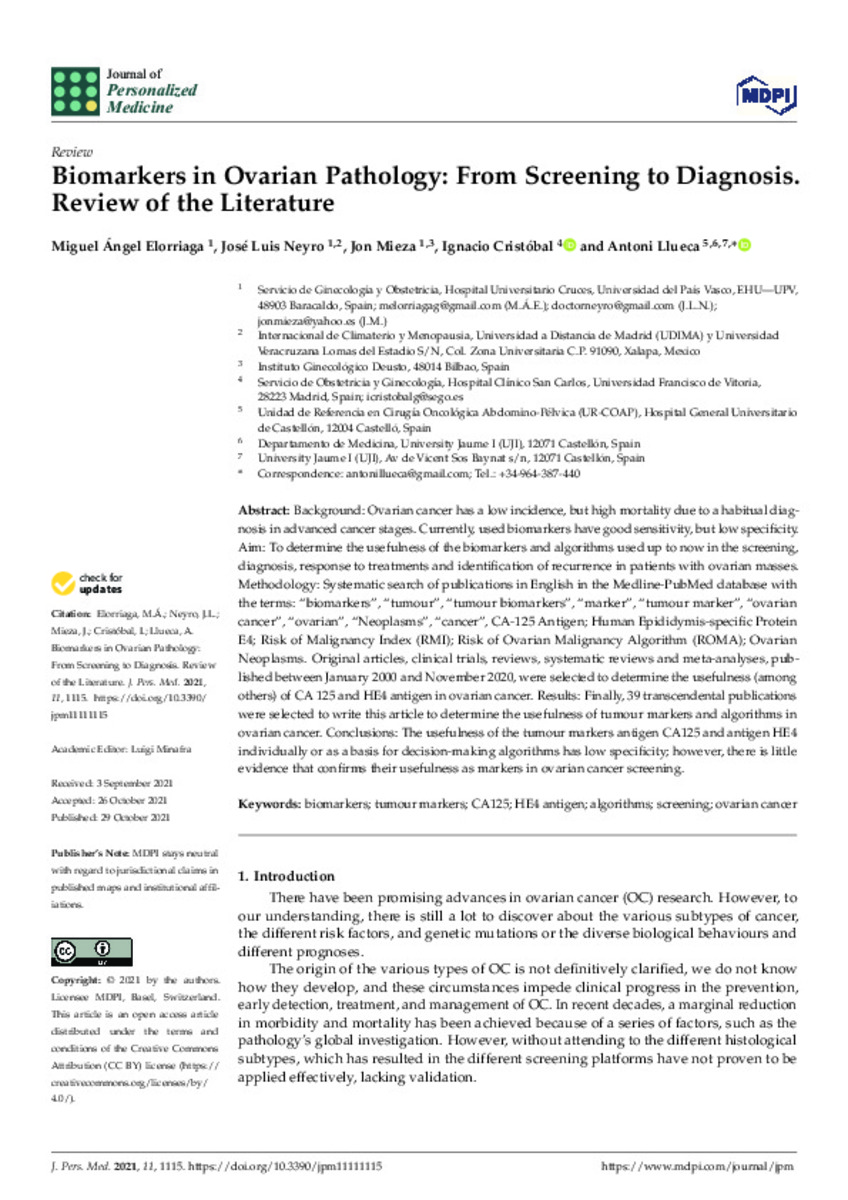Mostrar el registro sencillo del ítem
Biomarkers in Ovarian Pathology: From Screening to Diagnosis. Review of the Literature
| dc.contributor.author | Elorriaga, Miguel Ángel | |
| dc.contributor.author | Neyro, Jose Luis | |
| dc.contributor.author | Mieza, Jon | |
| dc.contributor.author | Cristóbal, Ignacio | |
| dc.contributor.author | Llueca, Antoni | |
| dc.date.accessioned | 2022-06-07T16:57:59Z | |
| dc.date.available | 2022-06-07T16:57:59Z | |
| dc.date.issued | 2021-10-29 | |
| dc.identifier.citation | Elorriaga, M.Á.; Neyro, J.L.; Mieza, J.; Cristóbal, I.; Llueca, A. Biomarkers in Ovarian Pathology: From Screening to Diagnosis. Review of the Literature. J. Pers. Med. 2021, 11, 1115. https://doi.org/10.3390/ jpm11111115 | ca_CA |
| dc.identifier.issn | 2075-4426 | |
| dc.identifier.uri | http://hdl.handle.net/10234/197937 | |
| dc.description.abstract | Background: Ovarian cancer has a low incidence, but high mortality due to a habitual diagnosis in advanced cancer stages. Currently, used biomarkers have good sensitivity, but low specificity. Aim: To determine the usefulness of the biomarkers and algorithms used up to now in the screening, diagnosis, response to treatments and identification of recurrence in patients with ovarian masses. Methodology: Systematic search of publications in English in the Medline-PubMed database with the terms: “biomarkers”, “tumour”, “tumour biomarkers”, “marker”, “tumour marker”, “ovarian cancer”, “ovarian”, “Neoplasms”, “cancer”, CA-125 Antigen; Human Epididymis-specific Protein E4; Risk of Malignancy Index (RMI); Risk of Ovarian Malignancy Algorithm (ROMA); Ovarian Neoplasms. Original articles, clinical trials, reviews, systematic reviews and meta-analyses, published between January 2000 and November 2020, were selected to determine the usefulness (among others) of CA 125 and HE4 antigen in ovarian cancer. Results: Finally, 39 transcendental publications were selected to write this article to determine the usefulness of tumour markers and algorithms in ovarian cancer. Conclusions: The usefulness of the tumour markers antigen CA125 and antigen HE4 individually or as a basis for decision-making algorithms has low specificity; however, there is little evidence that confirms their usefulness as markers in ovarian cancer screening | ca_CA |
| dc.format.extent | 13 p. | ca_CA |
| dc.format.mimetype | application/pdf | ca_CA |
| dc.language.iso | eng | ca_CA |
| dc.publisher | MDPI | ca_CA |
| dc.relation | ca_CA | |
| dc.relation.isPartOf | Journal of Personalized Medicine, Vol. 11, Issue 11 (November 2021) | ca_CA |
| dc.rights | Copyright: © 2021 by the authors. Licensee MDPI, Basel, Switzerland. This article is an open access article distributed under the terms and conditions of the Creative Commons Attribution (CC BY) license (https:// creativecommons.org/licenses/by/ 4.0/). | ca_CA |
| dc.rights.uri | http://creativecommons.org/licenses/by/4.0/ | ca_CA |
| dc.subject | biomarkers | ca_CA |
| dc.subject | tumour markers | ca_CA |
| dc.subject | CA125 | ca_CA |
| dc.subject | HE4 antigen | ca_CA |
| dc.subject | algorithms | ca_CA |
| dc.subject | screening | ca_CA |
| dc.subject | ovarian cancer | ca_CA |
| dc.title | Biomarkers in Ovarian Pathology: From Screening to Diagnosis. Review of the Literature | ca_CA |
| dc.type | info:eu-repo/semantics/article | ca_CA |
| dc.identifier.doi | https://doi.org/10.3390/jpm11111115 | |
| dc.rights.accessRights | info:eu-repo/semantics/openAccess | ca_CA |
| dc.type.version | info:eu-repo/semantics/publishedVersion | ca_CA |
| project.funder.name | Medtronic University Chair for Training and Surgical Research, Universitat Jaume I = Cátedra Medtronic de Formación e Investigación quirúrgica de la Universitat Jaume I | ca_CA |
Ficheros en el ítem
Este ítem aparece en la(s) siguiente(s) colección(ones)
-
MED_Articles [639]
Articles de publicacions periòdiques
Excepto si se señala otra cosa, la licencia del ítem se describe como: Copyright: © 2021 by the authors.
Licensee MDPI, Basel, Switzerland.
This article is an open access article
distributed under the terms and
conditions of the Creative Commons
Attribution (CC BY) license (https://
creativecommons.org/licenses/by/
4.0/).








